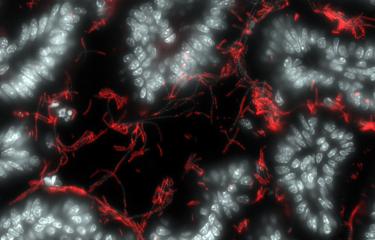Although several Listeria strains can cause listeriosis, some are particularly virulent. This is because they secrete a toxin that damages the intestinal microbiota, preventing it from serving as a barrier and promoting infection. The results of this study, carried out by Javier Pizarro-Cerdà's team in the unit led by Pascale Cossart (Institut Pasteur, INSERM, INRA), were published in the journal PNAS on May 2, 2016.
When pathogenic bacteria enter our digestive system – for example via contaminated food – they are confronted with various defenses used by the body, including the bacteria in our intestinal microbiota [all the microorganisms in the intestine]. However, some microbes manage to cross this protective barrier and infect the human organism. One such example is Listeria, especially the more virulent strains of these bacteria that cause listeriosis outbreaks. "For several years we have known that the genomes of these epidemic strains of Listeria contain specific pathogenicity islands – groups of genes that equip them with all the tools they need to cause disease," explains Javier Pizarro-Cerdà from the Bacteria-Cell Interactions Unit (Institut Pasteur, INSERM U604, INRA USC2020). "One of these islands enables the most dangerous strains of Listeria to produce a specific toxin known as Listeriolysin S."
This toxin was identified in 2008 but as yet little is known about its mechanism of action and its role in infection. The team led by Javier Pizarro-Cerdà attempted to shed light on the action of Listeriolysin S by orally administering toxin-producing bacteria to mice. "Bioluminescence imaging was used to follow the production of the toxin in vivo and to identify at what point and in what tissue Listeriolysin S was active," he explains. "Just six hours after giving the mice Listeria, we clearly saw bioluminescence around their belly area." The scientists were able to pinpoint the intestine as the only location in the body where the toxin was produced. They concluded that the toxin must therefore play an important, probably bactericidal role in the intestine.
To confirm their theory, the scientists exposed the bacteria to the toxin in vitro and observed that bacteria taxonomically close to Listeria, which are likely to use the same type of resources, were killed. Using metagenomics [the study of the genomes of all populations in a given environment, such as the bacterial populations in the intestine], they then compared the contents of the intestinal microbiota of mice that had ingested Listeriolysin S-secreting Listeria to those of mice that had ingested non-toxin-secreting bacteria. This led them to the same observation: some of the microbiota's bacteria disappeared when exposed to the toxin. "Interestingly, the bacteria that disappear are species that could potentially protect us from listeriosis," stresses Javier Pizarro-Cerdà. "Our theory is that this toxin enables the epidemic strain of Listeria to destroy bacteria that are potentially dangerous for it, to enter the intestine and then to infect other tissues."
Source
Bacteriocin from epidemic Listeria strains alters the host intestinal microbiota to favor infection, PNAS, May 2, 2016
Juan J. Queredaa,b,c, Olivier Dussurgeta,b,c,d, Marie-Anne Nahoria,b,c, Amine Ghozlanee, Stevenn Volante, Marie-Agnès Dilliese, Béatrice Regnaultf, Sean Kennedyf, Stanislas Mondotg,h, Barbara Villoinga,b,c, Pascale Cossarta,b,c, and Javier Pizarro-Cerdaa,b,c
aUnité des Interactions Bactéries-Cellules, Institut Pasteur, Paris F-75015, France;
bInstitut National de la Santé et de la Recherche Médicale, U604, Paris F-75015, France;
cInstitut National de la Recherche Agronomique, Unite Sous Contrat 2020, Paris F-75015, France;
dCellule Pasteur, Université Paris Diderot, Sorbonne Paris Cité, Paris F-75015, France;
eBioinformatics and Biostatistics Hub – Centre de Bioinformatique, Biostatistique et Biologie Intégrative, Unité mixte de Service et Recherche 3756 Institut Pasteur- Centre National de la Recherche Scientifique, Paris F-75015, France;
fBiomics Pole, Centre d'Innovation et Recherche Technologique, Institut Pasteur, Paris F-75015, France;
gInstitut National de la Recherche Agronomique, Unité Mixte de Recherché 1319 Micalis, Jouy-en-Josas F-78350, France;
hAgroParisTech, Unité Mixte de Recherché 1319 Micalis, Jouy-en-Josas F-78350, France
Mis à jour le 23/05/2016






